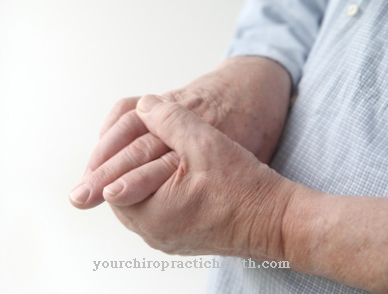The Restriction of movement indicates a temporary or permanent disturbance of the functionality of the skeletal and musculoskeletal system. A distinction is made between an active and a passive form. Restriction of movement is not a disease in the strict sense of the word, but a consequence of illnesses, injuries, operations and the natural aging process.
What is a movement restriction?

Restriction of movement is characterized by a partial or complete dysfunction of the bony musculoskeletal system as well as the soft tissue. A distinction is made between a movement restriction with an active and a passive range of motion. With a shoulder injury z. For example, there is an active restriction when the examining doctor moves the patient's arm. However, the shoulder range of motion can still be completely normal.
In the case of restricted mobility, the joint itself does not always have to be affected. For example, if the ligaments and tendons on the ankle are injured, the joint itself is fully functional and can be moved to a normal extent. However, the range of motion is severely restricted due to the injuries in the soft tissue. The following joints are often affected by restricted mobility: shoulder, hip, knee, ankle and elbow.
causes
The causes of restricted mobility are very diverse. Often injuries such as B. a fracture or a ligament stretch at the ankle is the cause of the disorder.
Furthermore, there are diseases that have the consequence that the mobility of the joints deteriorates over time. Rheumatism, osteoarthritis, spinal diseases and osteoporosis have a negative effect on the condition of the bones. Deposits as well as heavy wear and tear in the joints often lead to permanent restriction of movement. Neurological diseases also have an impact on mobility. Stroke, Parkinson's and multiple sclerosis have a significant impact on the functioning of the skeletal and musculoskeletal system.
Movement restrictions can also occur in childhood. If there is a motor and / or neurological disorder in early childhood development, this can lead to temporary as well as chronic movement restrictions.
Other factors that can limit mobility are obesity, the natural aging process, medication, drug and alcohol abuse, and cancer. Furthermore, operations can also result in restricted mobility.
You can find your medication here
➔ Medicines for back painDiseases with this symptom
- Inflammation of the hip
- Hip arthrosis
- disc prolapse
- gout
- Sciatic pain
- arthritis
- rheumatism
- Ligament strain
- Vertebral joint arthrosis
- Lumbago
- arthrosis
- osteoporosis
- stroke
- Parkinson's
- multiple sclerosis
Diagnosis & course
The orthopedic surgeon diagnoses the restricted mobility. In addition to a detailed anamnesis, a physical examination of the general condition is carried out. The mobility is determined with the help of the so-called NNM, the neutral-zero method. The extent to which a joint can move is measured in degrees. The orthopedic evaluation and documentation index shows the extent or extent to which the individual joints of the body can be moved.
The orthopedic surgeon instructs the patient to move in a certain direction. The doctor measures the range of motion of the joint and compares it with the guide values from the tables. This makes it possible to determine to what extent there is a movement restriction.
Since the causes of restricted mobility are very diverse, radiological diagnostics must be used, especially in the case of injuries.With the help of X-rays, ultrasound, CT and MRI you can see whether mechanical disorders are the cause and to what extent the joint is affected.
The progression of a restricted mobility depends on the cause. Is this based on an injury such as Torn ligament, full mobility is restored after a few weeks. If the restricted mobility is the result of an illness, this has a significant effect on the course. Temporary faults can usually be eliminated within a few weeks or months. In the case of permanent disorders, the movement disorder often develops parallel to the underlying disease. The further this progresses, the more pronounced the restriction of movement becomes.
Complications
The restriction of movement can be permanent, but it can go away again. It is always a disorder of the musculoskeletal system, here medicine differentiates between an active and a passive form. It is not an illness in itself, it is more the result of an illness, an injury or a sign of old age.
If the movement is restricted, the function of the skeleton is no longer given, but soft tissues can also be affected. There does not have to be an injury directly to the joint; tendons or ligaments can also render it completely immobile. The knee, ankle, hip or elbow are often affected. The causes are very diverse, at a young age the restriction of movement was mostly caused by a fracture or ligament stretching. But diseases also have very negative effects, diseases of the spine and osteoporosis should be mentioned here.
In older people, deposits or wear and tear often lead to restricted mobility, but strokes, Parkinson's or multiple sclerosis also often lead to permanent restricted mobility. Sometimes the restriction of movement is already noticed in childhood, usually there is an early childhood developmental disorder. Of course, being overweight can also significantly limit mobility and the natural aging process cannot be stopped. Alcohol, drugs, medication can also lead to restricted mobility and it is not uncommon for people to restrict their movement after an operation or during cancer treatment.
When should you go to the doctor?
Most people are quite familiar with minor movement restrictions. Everyone has a blockage from time to time. Often a joint cracks because it has jammed. A greater restriction of movement, which also lasts longer, should be discussed with the doctor. Most of the problems are orthopedic in nature.
If we sit a lot, the musculoskeletal system can be restricted. Tendons and muscles warp and shorten, others are constantly overstretched. The family doctor will refer you to the orthopedic surgeon, and chiropractors are also in demand here. Movement restrictions can also occur after exercise, for example due to sore muscles. Sporty people usually don't need a doctor for this. They know that the sore muscles will go away again. It looks different with accidents. Some restrictions occur as a result of a bruise, which can be more painful than a break. It also often lasts longer. The doctor will determine what it is.
Some restrictions are particularly important to keep an eye on. If in doubt, the doctor should be consulted more often than not enough. The cervical spine is a sensitive area and the same applies to the lower back. Age causes blockages just like a herniated disc. Whether small toe or shoulder joint: In many cases X-rays are taken, some are examined in what is known as a "tube" (the MRI machine or magnetic resonance tomograph).
Doctors & therapists in your area
Treatment & Therapy
Treatment of restricted mobility begins with determining the cause. Once a diagnosis has been made, the illness or injury that has resulted in restricted mobility can be treated.
In order to shorten or slow down the course of a restricted movement, it is necessary to move or the affected area of the body. Physiotherapy, occupational therapy and muscle building training are used together with other physical therapy forms such as Stimulation current therapy used to restore or improve mobility.
In the case of restricted mobility, it is important that the measures are started immediately. By taking it easy, poor posture can develop, which can lead to incorrect strain on other parts of the body. There is a saying: if you rest, you rust. If the movement is restricted, it is essential to keep the joint mobile. The longer you don't move a joint, the more difficult it becomes to restore mobility. In order to restore or improve mobility, additional aids can also be used, such as B. crutch, wheelchair and walker.
Outlook & forecast
The future prospects of restricted mobility depend heavily on the type and severity of the restriction. Therefore, no general prediction for this symptom is possible. In some cases, restricted mobility leads to psychological problems. For example, the patient complains of decreased self-esteem. Mental health problems are more likely to occur in people whose movement restriction occurs suddenly and has not been present since birth. In this case, treatment by a psychologist is possible.
The treatment of restricted mobility itself is not possible in every case. Physiotherapy or exercise therapies often help to combat the restricted mobility. In many cases, basic movements have to be relearned, which is relatively difficult for adults in particular. However, if no nerves are damaged, the restriction of movement can be treated relatively well.
If the restriction occurs after a bone fracture, the treatment is successful in most cases and the patient can move again afterwards. Treatment is often not possible for injuries to the spinal cord or spine.
You can find your medication here
➔ Medicines for back painprevention
Restriction of movement as a result of injuries and other illnesses cannot be prevented or can only be prevented to a limited extent. If you fall ill with an illness that will later lead to restricted mobility, measures such as physiotherapy, exercise therapy and adequate sporting activity should be taken from the start.
Appropriate preventive measures can include physical activity such as swimming, cycling, etc. With the help of targeted sports exercises and prophylactic physiotherapy, the muscles that support and fix the joints are built up. In this way, the joints are less prone to injuries, so that there is no need to restrict movement in the first place.
You can do that yourself
Movement restrictions encompass numerous clinical pictures. Affected people can no longer perform certain movements, for example stretching the arm in one direction, completely or not at all. If the symptoms persist for more than a week, a doctor should be consulted. If the restriction is the result of years of incorrect loading, the cause must be eliminated.
First of all, protection is important. In the case of shoulder and arm pain, the person concerned must not lift anything heavy until the inflammation has subsided. In the event of restricted mobility after operations, mobility is also carefully increased. Massages can promote blood circulation and reduce swelling. Warm full baths and infrared radiation can also relieve tension and bring more mobility. It is not advisable to force this. Rather, it must be restored slowly and gradually.
The restriction of movement is rarely the result of muscle weakness. Often tense opposing muscles, the atagonists, are the reason. For example, they can be shortened by inactivity and must now be trained. Mud packs, for example, help against inflammation, and anti-inflammatory ointments also improve the symptoms. Rigid connective tissue with poor blood supply can cause the same symptoms and can be remedied by targeted massages. The affected person can do this himself after training by a physiotherapist. A self-help group offers support and comfort and can improve the quality of life. Here, those affected get a lot of information about their clinical picture.
























.jpg)



